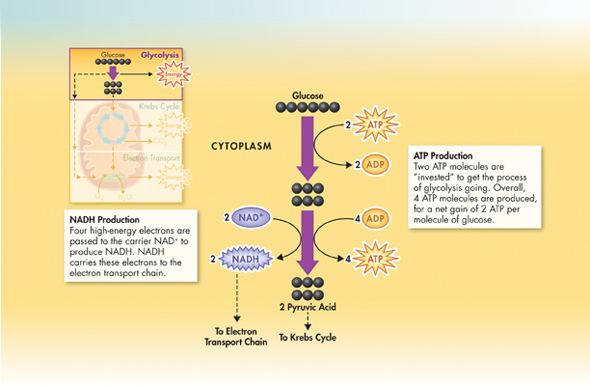ZOOMING IN
GLYCOLYSIS

FIGURE 9–4 Glycolysis is the first stage of cellular respiration. During glycolysis, glucose is broken down into 2 molecules of pyruvic acid. ATP and NADH are produced as part of the process. Interpret Visuals How many carbon atoms are there in glucose? How many carbon atoms are in each molecule of pyruvic acid?
ddNADH Production One of the reactions of glycolysis removes 4 electrons, now in a high-energy state, and passes them to an electron carrier called NAD+, or nicotinamide adenine dinucleotide. Like NADP+ in photosynthesis, each NAD+ molecule accepts a pair of high-energy electrons. This molecule, now known as NADH, holds the electrons until they can be transferred to other molecules. As you will see, in the presence of oxygen, these high-energy electrons can be used to produce even more ATP molecules.
The Advantages of Glycolysis In the process of glycolysis, 4 ATP molecules are synthesized from 4 ADP molecules. Given that 2 ATP molecules are used to start the process, there is a net gain of just 2 ATP molecules. Although the energy yield from glycolysis is small, the process is so fast that cells can produce thousands of ATP molecules in just a few milliseconds. The speed of glycolysis can be a big advantage when the energy demands of a cell suddenly increase.
Besides speed, another advantage of glycolysis is that the process itself does not require oxygen. This means that glycolysis can quickly supply chemical energy to cells when oxygen is not available. When oxygen is available, however, the pyruvic acid and NADH “outputs” generated during glycolysis become the “inputs” for the other processes of cellular respiration.
 In Your Notebook In your own words, describe the advantages of glycolysis to the cell in terms of energy production.
In Your Notebook In your own words, describe the advantages of glycolysis to the cell in terms of energy production.
BUILD Vocabulary
ACADEMIC WORDS The verb synthesize means “to bring together as a whole.” Therefore, a molecule of ATP is synthesized when a phosphate group combines with the molecule ADP, forming a high-energy bond.
Table of Contents
- Formulas and Equations
- Applying Formulas and Equations
- Mean, Median, and Mode
- Estimation
- Using Measurements in Calculations
- Effects of Measurement Errors
- Accuracy
- Precision
- Comparing Accuracy and Precision
- Significant Figures
- Calculating With Significant Figures
- Scientific Notation
- Calculating With Scientific Notation
- Dimensional Analysis
- Applying Dimensional Analysis




